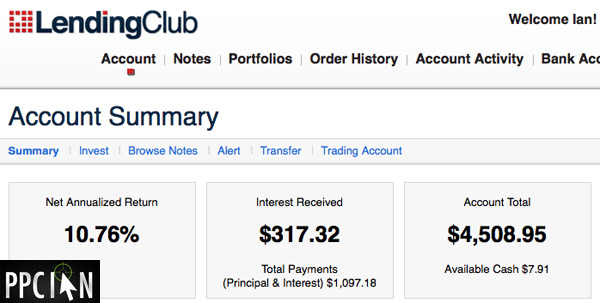It’s one of my 2012 Goals to save money and invest wisely. Where have I been investing my savings? Several places including stocks, my savings account, and the topic of today’s post – LendingClub. I’ve already written two exciting posts about Lending Club that you may wish to check out:
Today, I’m thrilled to share greater context behind my overall Lending Club strategy, how I personally pick Lending Club loans. Without further ado, here’s how I pick Lending Club loans worthy of investment.
- Rule 1: Don’t let Lending Club pick loans for you. Rather, click the little link to “browse notes” so you have full control over the precise notes in which you invest. How do I sort through the notes? Check out the next few bullet points!
- Rule 2: Invest in notes that don’t have many days left in their funding cycle. The more days you have your cash sitting around, the less interest you will earn. Also, loans closer to becoming fully funded are typically of higher quality (in my opinion). Why? Partially funded loans can always be reviewed by Lending Club staff and get rejected. If they’re closer to being fully funded, it’s likely they’ve been reviewed and are good loans. Moreover, you’re taking advantage of the collective intelligence of other investors. Go to the popular loans.
- Rule 3: Invest in low dollar amount loans. It’s a lot easier to pay back a $3,000 loan versus a $30,000 one. Generally, I feel like those taking out smaller loans have a more targeted, specific need for the money. They are more likely legit people. I get a bit concerned when folks are taking out major loans. As such, I’m sticking with small loans these days.
- Rule 4: Go with “A” and “B” loans. I’m a conservative investor and want to minimize loan defaults. I feel that it’s essential to stick with the top-rated loans to achieve this goal.
- Rule 5: Stick with debt refinance loans. It’s a simple equation: You take a high interest rate and consolidate your debt into a lower interest rate with Lending Club (bypassing the middle man). As compared to loans for other purposes, I just feel safer going with debt refinance loans since they’re all about saving someone money and reducing their monthly expenses (as compared to increasing their expenses, the case with other loans).
These tips are definitely not the only criteria for evaluating Lending Club loans, but definitely should provide a great starting point. My strategy is constantly evolving and these rules mark some of my latest thinking. Do you invest in Lending Club? Any special strategies for investing in Lending Club notes?

Important Note: I’m not a financial advisor and this is not financial advice. Please consult your own financial advisor before making any investment decisions.
Image in this post © PPCIan.com

Ian, thanks for your tips. 10% return is pretty cool. My saving account only gets me <1% these days.
I'm considering about saving/investing 10% of my online income in this Lending Club.
Regarding to "low dollar amount loans", what is your criteria? $1000? or $5000? Thanks!
Thanks for the comment, Kent! 🙂 That is a great question. In terms of “low dollar amount” it’s all relative to Lending Club’s maximum loan amount of $35,000 (the minimum is $1,000). I’m a huge fan of loans in the $1,000-$6,000 range since they are smaller (and therefore easier to pay back). These days, my first preference is to grab and A or B debt refinance loan between $1,000 and $6,000. If those aren’t available, I’ll sometimes go up to $12,000 but typically not much more than that. In my early days, I had invested in loans > $12,000 but I’m not doing that anymore, as my strategy continues to evolve!
All the best,
Ian
I complete agree with Rule 1 – to get the best returns at Lending Club you need to pick the loans yourself. As for Rule 2, your readers should know that any loan can be rejected by Lending Club even if it is fully funded – there are certain verification processes that are independent of the popularity of the loan with investors. But Rule 3 is the rule I most take issue with. While your logic may seem sound data analysis actually tells a different story. The average ROI on all Lending Club loans that are less than $10K is actually less than the ROI on loans of more than $10K.
Now, obviously you can still create a great return by focusing on smaller loans but the numbers demonstrate that on average larger loans provide a better return for investors.
Hi Peter,
Thanks so much for the comment! I very much appreciate it. My Lending Club strategy is still a work in progress so I’m always open to feedback and new ideas.
In terms of rule #2, that is true that LC can still disapprove a fully funded loan / almost fully funded loan. That said, in my personal experience, if you get into a loan when it’s 95% funded vs. 0% funded, you get your money working for you faster. I have experimented with both and have found that the loans closer to being fully funded get fully funded quickly and start paying interest quicker. Also, my experience has shown that those loans closer to being fully funded get disapproved less frequently (whereas the number of 0-5% funded loans getting disapproved is far higher). Why? My guess is that LC is doing a great job policing the loans and catches the bad ones quickly, before many investors have looked at them.
In terms of rule #3, I like where you’re going and would love to dig into the data more. I now see that it’s available in the “statistics” section so I’m looking forward to checking this out! I’m an online marketer and live/breathe data, so this is awesome. Now that my loan portfolio is growing and I have been on the platform longer, I am getting a few loans that are falling behind. When I look at those loans, they tend to be be larger ones. As such, this personal experience has influenced my own strategy. Now, my data is not statistically valid because it’s a low sample size, but nonetheless it’s the data I’ve got so I use it to shape my strategy.
Here’s where I would like to dig in a bit deeper… ROI is largely dependent on interest rate (which is dependent on risk profile/classification of the loan, term of the loan, size of the loan, etc.). We would need to look not only at overall ROI by loan size but at ROI for a similar class of loans (basically all “A” loans below $10,000 vs. all “A” loans above $10,000 that have the same loan term). Also, would like to take interest rate out of the equation and just look at raw late/default rate too. Basically, what percent of “A” loans below $10,000 default and what % above $10,000 default? I’m a risk averse lender so my strategy here is to minimize defaults overall.
Want to do some apples to apples comparison to prove that it’s not a loan basket mix issue here and that loans > $10,000 truly do have a better ROI when you normalize for risk profile (since I’m not willing to take on more risk to achieve a higher return). If we’re able to prove here that “A” loans below $10,000 default at a higher rate than “A” loans above $10,000 (with both baskets having the same term), I would change my strategy. Then, we would also want to look at this by tiers (maybe there’s some sweet spot that we can go after such as loans between $10,000 and $20,000). Anyways, like where you’re going and may do this analysis as part of a future blog post!
Thanks again for your comment and looking forward to seeing any data you may have!
All the best,
Ian
I think digging deeper is the way to go and I don’t recommend using the stats on Lending Club’s site. A far better option is Lendstats.com where you can run searches on the entire loan history with data that is updated daily. I have created an intro video for Lendstats here: http://www.sociallending.net/social-lending-101/a-beginners-guide-to-lendstats-com/
If you only stick with A and B loans, you aren’t maximizing your potential return. My guess is you’ll end up in the 7-9% range whereas if you pick wisely using lendstats.com, you will end up in the 10-13% range. Yes the loans are riskier, but if most pay off you be in better shape than if you never have an A fail.